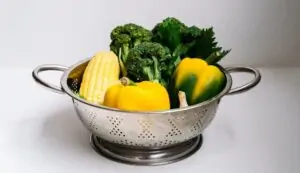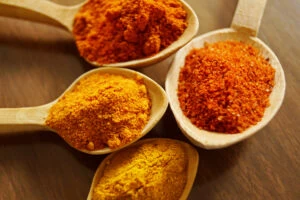In the kitchen, we steep it in olive oil and drizzle it everywhere, make tea, and pop its dried or fresh sprigs in stews and meat dishes while they cook.
Its one of those aromatic plants that grows tall and hairy along the sidewalk to the park. Its essential oils bust from the leaves when I brush past, or after a heavy rain coaxes.
Rosemary is one of many must-have plant foods that is delicious, smells of home and family and gardens, and that is also full of volatile oil that gives your hair a gorgeous shine and your brain a quicker tick.
What Is Rosemary
Rosemary is an annual shrub, an herb with potent flavor and aroma. Rosemary is known scientifically as “Rosmarinus officinalis,” which referrs to “dew” and “sea” in Latin. It’s also known as dew of the sea, sea dew, Ros Maris, rosmarine, Rosemarie, guardrobe, and incensier.
Rosemary is known as a compass plant or compass weed, a family of long-lived, tall plants. It’s also in the mint family (Lamiaceae).
Rosemary is native to the Mediterranean region, and it grows around the world in warm climates, such as South America, but gets along just fine in the rainy pacific by my favorite foggy, pined park.
Rosemary leaves are thick and needle-like, and the shrub has pale blue flowers, or sometimes white. Rosemary blossoms according to its internal clock, usually set to early summer (and other random times of the year). The aroma of rosemary rosmarinus officinalis wafts after a fresh rain or if you rub the leaves between your fingers.
Rosemary Flavor
Brush past a rosemary plant that towers over the sidewalk, or smell the air after a good rain, and you’ll smell any nearby rosemary.
Rosemary is a bitter herb with a bunch of notes mingling inside, including woody, pine, sage, lavender, mint, and lemon. The aftertaste is mostly bitter and acidic.
Cooking with Rosemary
Rosemary tastes beautiful as a lone herb in both sweet and savory dishes, or combined with other herbs like sage, thyme, or oregano.
Some of the most talked-about and gobbled-up savory pairings include breads, cheese, butter, sausage, white meat, garlic, and root vegetables. Rosemary is a bright and woodsy addition to sweets too, including chocolate and coffee beverages, pastries and bakes like olive oil cake, and citrusy syrups and citrus fruits.
It’s flavor and aroma grows through cooking, so start little and add. Start with a sprig or teaspoon of shopped, fresh or dried rosemary in a dish for four to six.
Rosemary is often associated with Thanksgiving in the United States, and an Asian-American recipe for milk bread rolls made made from tangzhong, with sweet potato and rosemary could be the essential tipping point for more on Thanksgiving day and every day before and after. Accompany with pot roast.
Rosemary Tea
Rosemary tea was used back in the day (and might hold its magic today) for warding off evil, and also to aid digestion. Chop a few leaves and boil in water. Filter the leaves out of the water or leave to sit a little longer for a stronger-flavored rosemary tea.
Rosemary tea is known to soothe an overworked belly, and by simply inhaling the rosemary tea’s smell, the herb can get to work to improve your cognitive performance on a big day (and small ones).
How To Save Rosemary
Save fresh rosemary in the fridge for up to three weeks by wrapping the sprigs in a damp paper towel and sealing in a bag or container.
If you have more fresh rosemary than you can use in three weeks, seal it in a containers or bags and freeze for six months or more. Or, chop the fresh or dry rosemary and sprinkle 1 teaspoon in each ice-cube tray pocket, and fill with water for easy soup seasoning later.
Dry Your Own Rosemary
Rosemary is easy to dry. Hang a bunch on a nail in a cool, dark, dry place until the needles easily fall off the sprigs when touched. You can also dry rosemary in an oven set at its lowest temperature.
Rosemary Infusions
Rosemary is one of many culinary herbs that can be used to infuse oils, vinegars, or wines. Set aside a bottle filled with your preferred liquid and add several tablespoons of fresh or dried leaves or a large sprig of rosemary. After two to three weeks, your infusion will smell strongly of rosemary and be ready for adding to veggies or meats as they cook, to toast rice before steaming, or as an after-drizzle on salads and sliced bread.
Rosemary Substitutes
If rosemary focaccia (or beef, stew, fish, and the rest) is your craving but you don’t have any rosemary, there are several other herbs that have similar flavor profiles to rosemary and that can sit in as a substitute.
Dried Rosemary
Start with dried rosemary if you’re out of fresh but dried is in your cupboard. Substitute dry for fresh using a third the amount that you would have used of fresh (3:1), since dried rosemary is much more potent than fresh.
Thyme
Thyme, fresh or dry, is a lighter flavor than rosemary (if you’re looking for something bolder, use sage). Substitute thyme as a garnish in salads or breads. It’ll carry its own thymey flavor, but will offer a similar herbal essence that rosemary would have offered.
Sage
For a strong dish made with super flavorful vegetables, heavy meats or fats, look to sage for a rosemary substitute. Sage packs a similar bitterness and musty, citrusy flavor like rosemary. Substitute using 1:1 for a strong flavor, or start with half (1/2:1) and work your way up if you’re nervous about overpowering a lighter food. Once food is around three-quarters cooked, taste the liquids (running fats in meat dishes, skimmed broth in soups and stews) and check the smell of baked goods to know if adding more sage is safe. If the taste is slightly bitter and the smell is musty, you’ve added enough. Remember that the flavors grow through more cooking.
Savory
Savory tastes similar to thyme and has a similar potency. Use fresh or dried savory as a rosemary substitute with a ratio of 1:1 in sweet or savory dishes, and add a little extra for more earthy flavors.
Where To Buy Rosemary
If it’s not growing in your backyard or on the edges of the park, rosemary can typically be found in any green grocer where chilled salad fixings are sold. You’ll find the fresh rosemary sprigs in a clam shell case. You can also find dried rosemary in small jars in the spice isle.
Rosemary essential oil is sold in most health food stores and occasionally in the cosmetics or medicine isle.
Try rosemary cooking products like rosemary salt. Its a delicious garnish on salads and any other food that pairs well with rosemary. Try sprinkling on pastries and breads as they bake.
Health Benefits Of Rosemary
Eating with rosemary is about more than its wonderful flavor and smell. The essential oil in rosemary that mingles with foods is good ingested to work wonders on your body in and out.
Rosemary rosmarinus officinalis is used in traditional medicine in the form of rosemary tea, rosemary extracts, and rosemary essential oil.
Use rosemary in all areas of your life to reap all of the benefits of rosemary:
- Reduce dry scalp, promote hair growth and prevent baldness
- Improve sleep quality
- Lower high blood pressure, improve blood circulation
- Strengthen the immune system
- Manage healthy weight gain
- Support brain aging and cognitive function like helping to improve memory
- Support good eye health
- Prevent heart disease
- Rid bad breath
Be sure to do your research and follow a trusted healthcare provider before using rosemary in frequent, large doses so that you receive only the potential health benefits and no adverse reactions from this beautiful herb.











